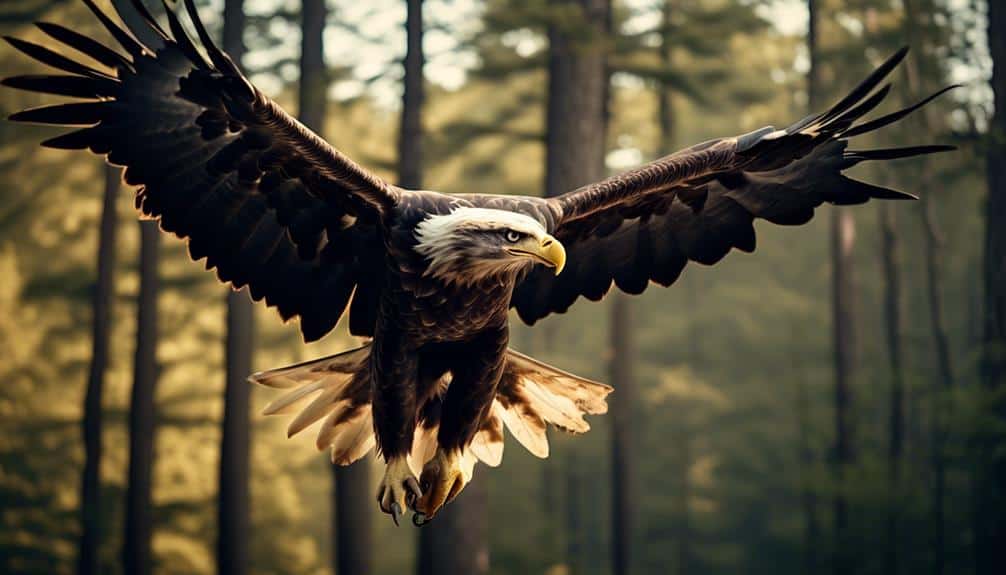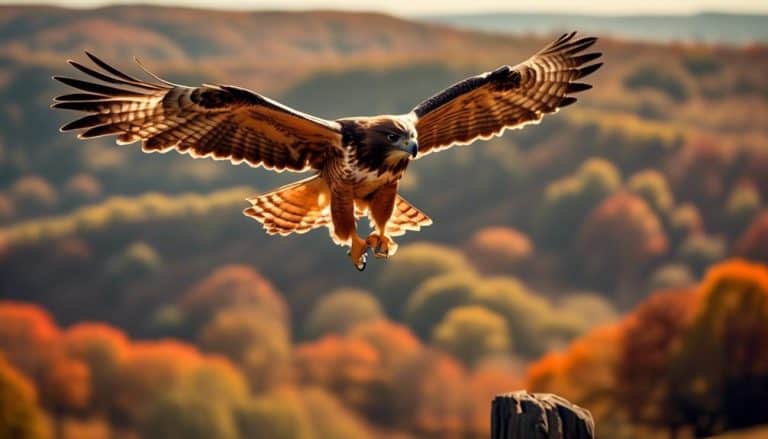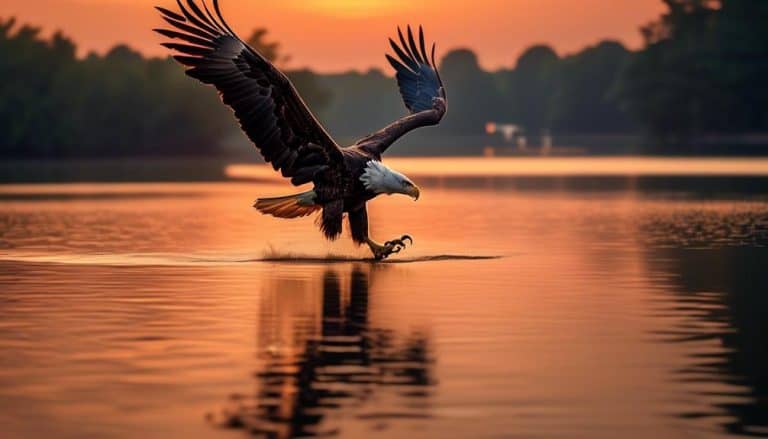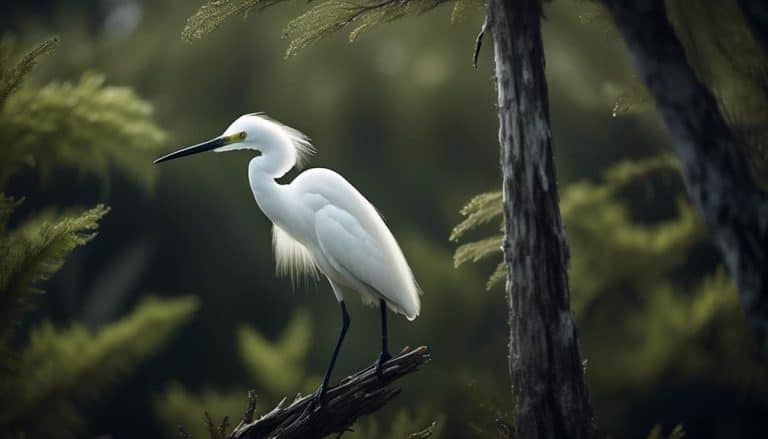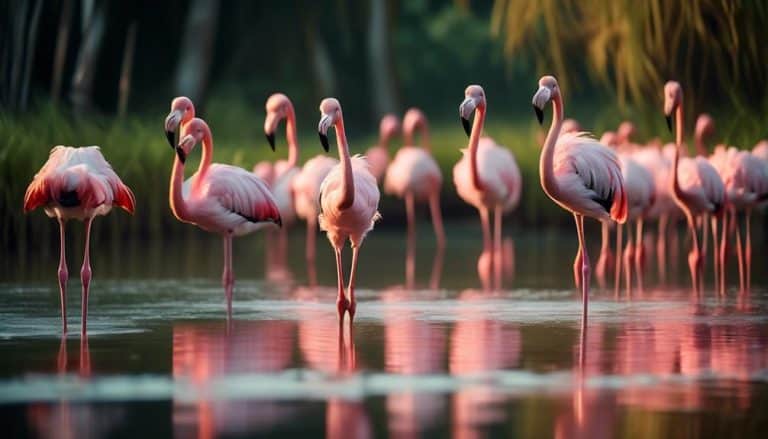As I stand on the edge of the vast Arkansas wilderness, the air crackles with an electric anticipation. The skies above are a theater, where nature's finest aerial acrobats take center stage. Birds of prey, majestic and formidable, rule the realm of the heavens.
From the iconic Bald Eagle soaring with unrivaled grace to the stealthy Red-tailed Hawk, these magnificent creatures captivate both the eye and the imagination. But there is so much more to discover in this avian kingdom, each species with its own unique traits and hunting techniques.
Join me on a journey through the untamed landscapes of Arkansas, where the stories of these winged predators unfold.
Bald Eagle – The Iconic Symbol of Arkansas
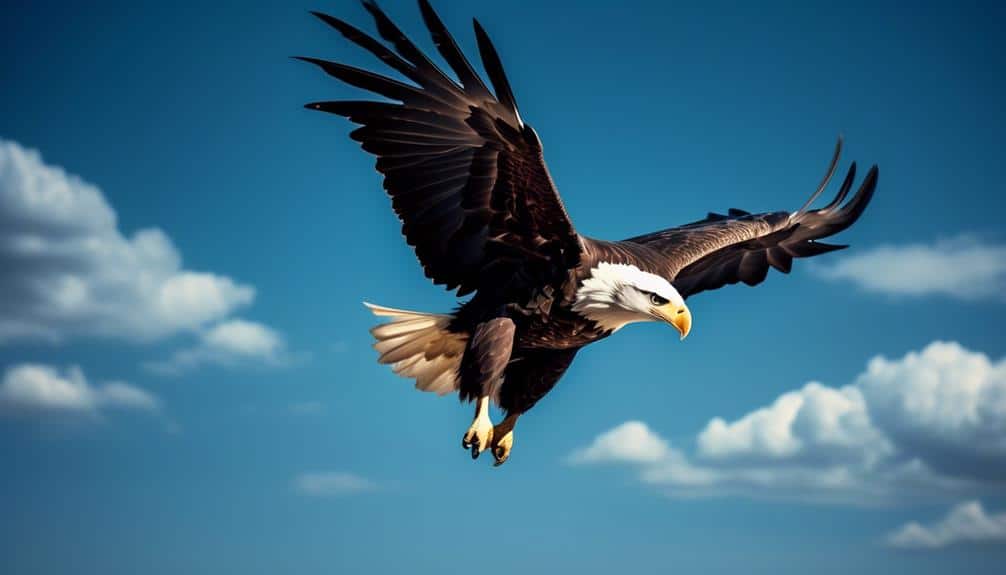
The Bald Eagle, a majestic bird of prey, is widely recognized as the iconic symbol of Arkansas. Over the years, efforts have been made to conserve and protect the bald eagle population in Arkansas, resulting in significant growth.
Bald eagle conservation in Arkansas has been a priority for wildlife agencies and organizations. Measures have been implemented to preserve the habitat and protect nesting sites. Wetlands, rivers, and lakes are crucial for the eagles' survival, as they provide ample food sources and suitable nesting locations.
Due to these conservation efforts, the bald eagle population in Arkansas has steadily increased. The removal of the bald eagle from the endangered species list in 2007 is a testament to the success of these conservation initiatives. This achievement highlights the positive impact of habitat preservation and the regulation of harmful activities.
The population growth of bald eagles in Arkansas is a result of increased nesting success and improved survival rates. The availability of suitable nesting sites and reduced disturbance from human activities have contributed to the eagles' reproductive success. Additionally, the ban on harmful pesticides, such as DDT, has played a significant role in the recovery of the population.
Red-tailed Hawk – The Stealthy Hunter
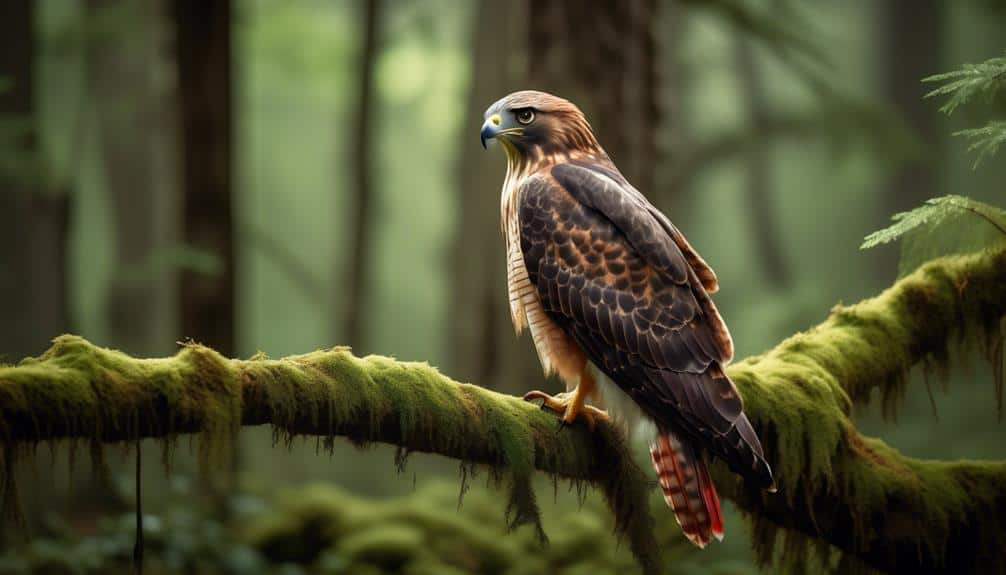
After examining the success of bald eagle conservation efforts in Arkansas, it's important to now shift our focus to the red-tailed hawk, a stealthy hunter found in the state. The red-tailed hawk (Buteo jamaicensis) is a common raptor known for its broad wings, reddish-brown tail, and piercing gaze. This species plays a crucial role in the local ecosystems of Arkansas.
Red-tailed hawks employ various hunting techniques to secure their prey. They primarily rely on their exceptional vision to detect small mammals, birds, and reptiles from high perches or while soaring in the sky. Once a potential prey is spotted, they stealthily dive down, using their sharp talons to capture and kill it. Their hunting prowess is further aided by their acute hearing, enabling them to locate prey hidden in vegetation or beneath the ground.
The impact of red-tailed hawks on local ecosystems is profound. By preying on rodents, these hawks help control their populations, preventing overgrazing and the spread of disease. Additionally, their presence acts as a natural deterrent for smaller birds, reducing competition for resources. This, in turn, allows for a more balanced and diverse ecosystem.
American Kestrel – The Colorful Falcon
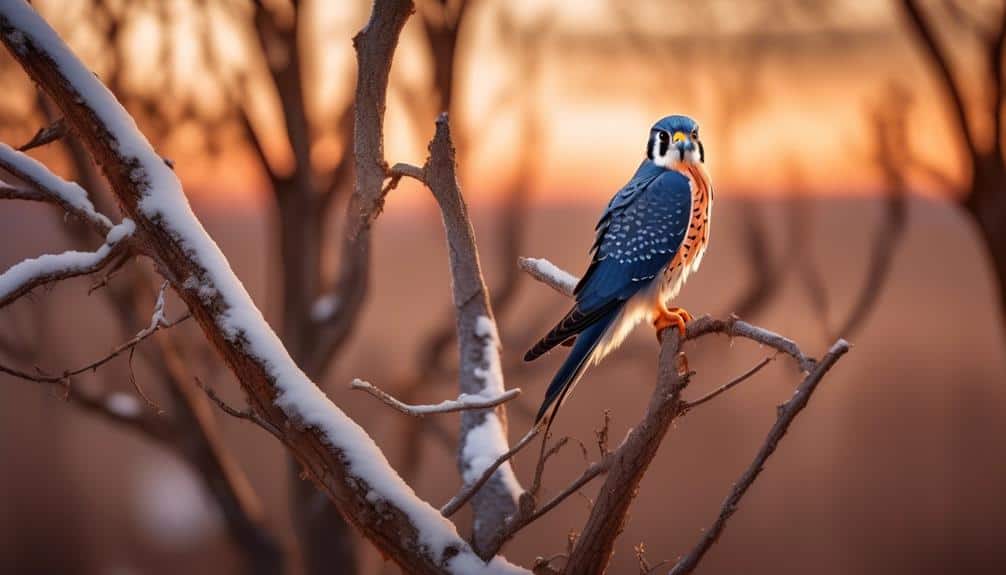
Spotting vibrant colors against the sky, the American Kestrel, a falcon species found in Arkansas, captivates observers with its striking appearance. This small falcon species showcases stunning colorful plumage, making it a delightful sight for bird enthusiasts. Let's take a closer look at the fascinating features of the American Kestrel.
To better understand the colorful plumage of the American Kestrel, let's explore its distinct markings:
| Body Part | Coloration |
|---|---|
| Head | Slate blue |
| Back | Rusty red |
| Tail | Black and white |
| Wings | Pale blue |
The combination of these colors creates an exquisite palette that distinguishes the American Kestrel from other birds of prey. The male kestrels are particularly vibrant, with their slate blue heads and rusty red backs, while the females exhibit a more subdued plumage with brown tones.
Measuring around 9-12 inches in length and weighing only 3-5 ounces, the American Kestrel is one of the smallest falcon species. Despite its diminutive size, it possesses impressive hunting skills and agility. Its colorful plumage aids in camouflage during hunting, enabling it to blend into its surroundings and surprise its prey.
Cooper's Hawk – The Agile Forest Predator
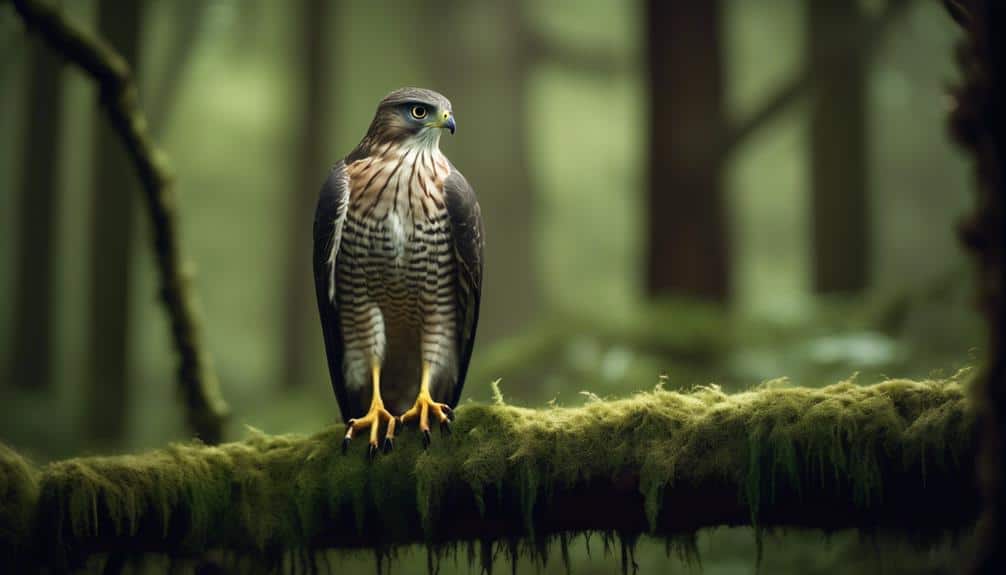
Cooper's Hawk, known for its agility and prowess in forested areas, is a formidable predator. This agile forest predator possesses unique hunting techniques that enable it to thrive in its woodland habitat. With its sleek body and long tail, the Cooper's Hawk is perfectly adapted for maneuvering through dense vegetation and swiftly navigating the forest canopy.
When hunting, the Cooper's Hawk relies on its exceptional agility to surprise and capture its prey. It employs a strategy known as 'still-hunting,' where it perches quietly and patiently waits for an opportunity to strike. This technique allows the hawk to blend seamlessly into the surrounding foliage, making it almost invisible to its unsuspecting prey.
Once a potential target is spotted, the Cooper's Hawk springs into action with astonishing speed and precision. It utilizes its short, rounded wings to maneuver swiftly through the dense forest, effortlessly dodging obstacles and swiftly changing direction. Its long, powerful legs enable it to make quick and accurate aerial maneuvers, ensuring a successful pursuit.
The Cooper's Hawk primarily preys on small to medium-sized birds, which it catches mid-flight using its remarkable agility. With its sharp talons and hooked beak, it swiftly dispatches its prey, ensuring a quick and efficient kill. This agile forest predator is truly a marvel of nature, perfectly adapted to thrive in the dense woodland habitats of Arkansas.
Great Horned Owl – The Silent Night Hunter
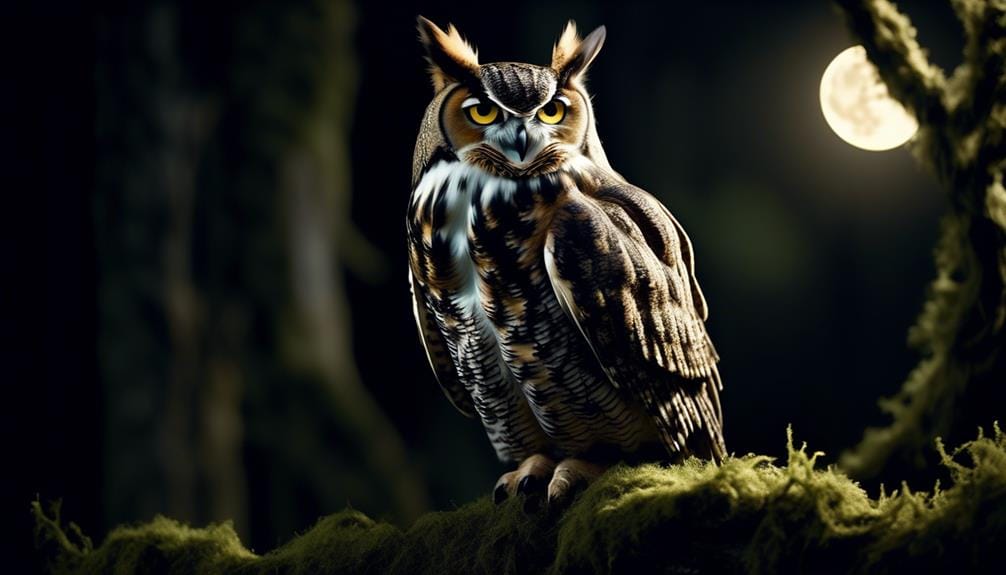
The Great Horned Owl, a master of nocturnal hunting, possesses remarkable stealth and precision in its pursuit of prey. This owl species is known for its silent night hunting techniques, allowing it to surprise its victims without being detected. With its large size, powerful talons, and sharp beak, the Great Horned Owl is an apex predator in the avian world.
When it comes to diet preferences, the Great Horned Owl is an opportunistic hunter, capable of capturing a wide range of prey. Its diet includes small mammals such as mice, rats, rabbits, and squirrels. Additionally, it preys on birds, reptiles, amphibians, and even other owls. This adaptability in diet enables the Great Horned Owl to thrive in various habitats across Arkansas.
To execute its silent night hunting techniques, the Great Horned Owl relies on several key adaptations. Its feathers are specially designed to muffle sound, allowing it to fly silently through the air. With its acute hearing and excellent night vision, it can locate prey even in complete darkness. Once a target is spotted, the owl swoops down with precision, using its sharp talons to grasp and immobilize the prey.
Mississippi Kite – The Graceful Migrant
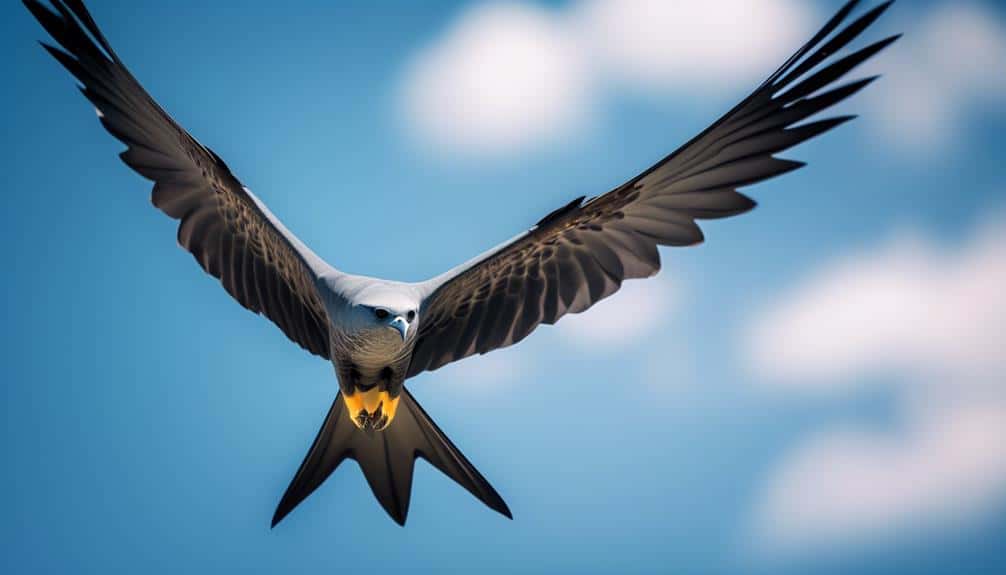
The Mississippi Kite, known for its graceful flight and migratory patterns, is a fascinating bird species found in Arkansas. As a migratory bird, the Mississippi Kite undertakes long-distance journeys to and from its breeding grounds. These migration patterns are characterized by the kite's impressive ability to cover significant distances, with some individuals traveling thousands of miles. During their migration, Mississippi Kites primarily rely on thermals, rising columns of warm air, to soar effortlessly through the sky. This efficient flight strategy allows them to conserve energy and cover large distances with minimal effort.
In terms of diet and feeding habits, the Mississippi Kite is a carnivorous bird. Its diet mainly consists of insects, particularly grasshoppers, crickets, and beetles. They're also known to feed on small vertebrates, such as lizards and small birds. The kite's hunting technique involves scanning the ground from above, searching for prey. Once a suitable target is spotted, the kite will dive down with impressive speed and agility, capturing the prey with its sharp talons.
Frequently Asked Questions
What Is the Average Wingspan of a Bald Eagle in Arkansas?
The average wingspan of a bald eagle in Arkansas is estimated to be around 6-7 feet. Population estimates suggest that there are approximately 150-200 nesting pairs of bald eagles in the state.
How Many Red-Tailed Hawks Are Estimated to Be Living in Arkansas?
There must be thousands of red-tailed hawks soaring through the Arkansas skies! Their population is estimated to be quite abundant, thanks to dedicated conservation efforts focused on protecting these majestic birds.
What Is the Preferred Habitat of the American Kestrel in Arkansas?
The American kestrel in Arkansas prefers nesting sites in open areas such as grasslands, agricultural fields, or along roadsides. They use their hunting techniques, including hovering and diving, to catch small prey like insects and small mammals.
How Does the Cooper's Hawk Hunt in the Forest?
In the forest, the Cooper's hawk displays impressive hunting techniques. With swift precision, it weaves through the trees, using its keen eyesight to spot prey. Its agile wings allow for quick maneuvers, ensuring a successful hunt.
What Is the Main Diet of the Great Horned Owl in Arkansas?
The main diet of the great horned owl in Arkansas consists of small mammals, such as rabbits, mice, and squirrels. They are also known to eat birds, reptiles, and occasionally fish. In Arkansas, great horned owls nest in a variety of habitats, including forests and open woodlands.
Conclusion
In conclusion, the birds of prey in Arkansas exhibit remarkable adaptations and hunting strategies that allow them to thrive in their respective habitats.
From the iconic Bald Eagle to the stealthy Red-tailed Hawk and the colorful American Kestrel, each species plays a vital role in maintaining the delicate ecological balance.
Their agility, silent hunting techniques, and graceful migration patterns make them awe-inspiring creatures to observe.
These birds are truly the masters of their domains, embodying the beauty and power of nature.

